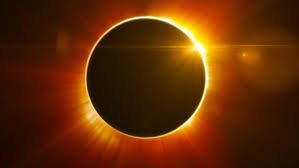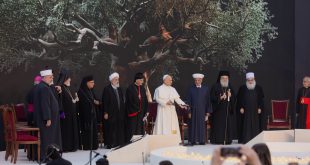A total eclipse that crossed the sky from Oregon to South Carolina brought
out throngs of spectators, who exulted in seeing the midday sky go briefly dark.
The New York Times
CHARLESTON, S.C. — The United States basked in the glory of a total eclipse on Monday, as the moon’s shadow swept from the rocky beaches of Oregon to the marshes of South Carolina.
Over an hour and a half, along a 70-mile-wide ribbon of land, in tiny towns like Glendo, Wyo., and metropolises like Nashville, on dirt roads and superhighways, in modest yards and grand national parks, coastal lowlands and high mountains, the world appeared to hush for a few minutes as the moon stood up to the sun, perfectly blocking its fierce light except for the corona, the halo of hot gas that surrounds it.
This was totality, an event that had not happened in the continental United States since 1979 and had not traversed such a broad swath of the country in nearly a century.
Darkness descended, the summer air caught a quick chill, Venus and some stars appeared in the near-night sky and, in Depoe Bay, Ore., one of the first places to fall under the shadow, a flock of confused sea gulls began to call out.
Even humans — who knew what was going on — were left to hunt for words to describe the spectacle.
“I’m in awe,” whispered Ibeth Arriaga, who had traveled from Los Angeles to Depoe Bay, where, despite some fog, the moon’s slip across the sun was just visible.
The weather cooperated along much of the eclipse’s path, which included parts of 14 states. Scientists in Salem, Ore., who had gambled that skies would be clear, were not disappointed. They shouted and hugged each other as totality ended, knowing that their cameras and other instruments — many of them meant to gain a better understanding of the mysterious corona — captured the eclipse under ideal conditions.
“This was absolutely fabulous,” said Jay Pasachoff, an astronomer at Williams College and one of the leading eclipse watchers in the world, who led the scientific team in Salem. “As perfect as possible.” There would be plenty of data to keep his graduate students occupied, he added with a grin.
But clouds affected viewing in some places, easing up briefly to offer a glimpse of totality in Beatrice, Neb., and Kansas City, Mo., and obscuring it completely in Charleston.
Nowhere was the weather more of a tease than in Carbondale, Ill., a hotbed of activity for scientists from NASA and other places, where 14,000 people gathered to watch in the football stadium of Southern Illinois University.
After a morning of brilliant sunshine, a line of enormous clouds began to appear in the hour before totality. At 10 minutes to zero-hour, all seemed lost despite chants from the crowd, pleading with the clouds to move.
With five minutes to go, the clouds opened up — to huge cheers — only to close again. Then another brief break allowed a view of the first moments of totality before this window, too, closed.
But being in Carbondale, where totality lasted a generous 2 minutes 38 seconds, paid off. Another gap in the clouds opened up, and the eclipsed sun was visible for a few more moments as totality ended.
“That one little second was beautiful,” said Masumi Iriye, from Urbana, Ill.
Over the weekend and into Monday, people had flocked to places where they could see the full eclipse, clogging roads, filling hotel rooms and taxing local facilities in some places.
Some paid nothing to see the spectacle; others paid a lot. For both, the experience proved overwhelming.
A couple from Portland got out of their minivan along a guard rail on Interstate 5 in Oregon — against advice from the state police, who worried that eclipse watchers might become highway hazards. Michael and Nancy Worstell, 71 and 73 years old, clutched each other, beamed and laughed as totality began. Trucks barreled past them, oblivious to the show in the sky.
Mr. Worstell, who like his wife is deaf, explained — by writing on a pad — that he had always regretted that the last total eclipse in Portland, in 1979, took place under cloudy skies.
He had no regrets this time. He lifted his two hands to his eyes and raised his index fingers to form a smile at the corners of his eyes. Then as totality ended and the sky brightened, the Worstells got back in the minivan and continued their drive north.
Less than 20 minutes later, people who had paid $595 for a private viewing party on Snow King Mountain near Jackson, Wyo., stopped sipping their mimosas as totality arrived. A string trio that had been entertaining them put down their instruments.
The crags of the Tetons blushed scarlet as if in the last robes of dusk, and a cheer raced through the crowd. People laughed uncontrollably and stammered as they stared dumbfounded at the midday darkness. Strangers hugged each other. For a brief moment everyone’s attention was as aligned as the moon and the sun.
“Magical,” said Jennifer Ross, a violinist who had been playing for the crowd minutes before totality. She was trembling. “Honestly I was ready to not be that impressed, but it was spiritual.”
Ten minutes later in the ranch town of Glendo, population 204, some of the thousands of visitors watched from a beach on a reservoir as totality set in.
One couple thanked God that they had skipped work. Others tore off their eclipse glasses, screamed and danced.
Outside the path of totality, where the sun and moon offered only a partial eclipse, reactions were generally more muted.
But ignoring the spectacle entirely was difficult, since none of the 50 states was untouched. Even in Anchorage, nearly half the sun was blocked by the moon at the height of the eclipse, about 9:15 a.m. local time.
In New York, where about 70 percent of the sun was eventually blocked, office workers left their desks and crowded the streets for a view.
At the White House, President Trump, his wife and their son Barron walked onto the Truman Balcony shortly before the eclipse reached its maximum of 81 percent.
Mr. Trump at first glanced up at the sun without wearing protective glasses, ignoring the shouts of an aide below. Later he and the rest of the family donned the glasses and watched the partial eclipse for about a minute and a half before going inside.
In St. Louis, the largest metropolitan area along the eclipse path, the northern boundary of totality sliced diagonally through the city just two miles south of downtown.
An estimated 10,000 people gathered in Jefferson Barracks Park, on a bluff overlooking the Mississippi River, well inside the totality zone. Shortly before the total eclipse, locusts began chirping in the trees, only to be drowned out by roars from the crowd.
Terry McGarrigle of White Plains, N.Y., traveled to St. Louis to experience totality firsthand. “You can read about it, but I am a witness to something powerful in the universe,” she said.
In downtown St. Louis, people jammed rooftops to witness a near-total eclipse. The sudden dusk caused street and bridge lights to turn on.
Here in Charleston, the final city on the eclipse route, the clouds wreaked havoc with totality. But with classes starting Tuesday, hundreds of College of Charleston students gathered for a campus viewing of the eclipse celebrated anyway.
They hooted and hollered as the moon slowly worked its way across the sun — a sight that, with glasses, was visible through the clouds. And they screamed again after totality, when a crescent sun again made an appearance.
Then the eclipse headed past Fort Sumter in Charleston Harbor, across slivers of coastal wetlands and out over the Atlantic Ocean, where it ended for good at sunset near Africa.
The nation won’t have to wait decades for the next one — a total eclipse will sweep from Texas to Maine on April 8, 2024.
 Lebanese Ministry of Information
Lebanese Ministry of Information



